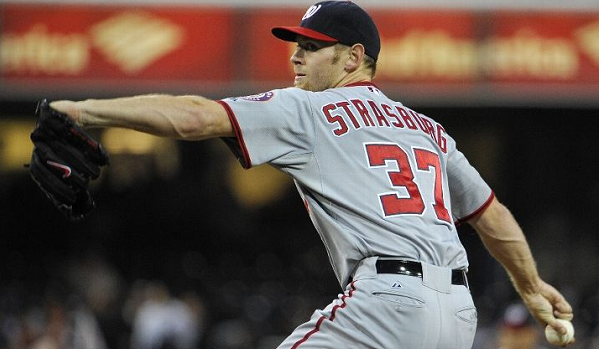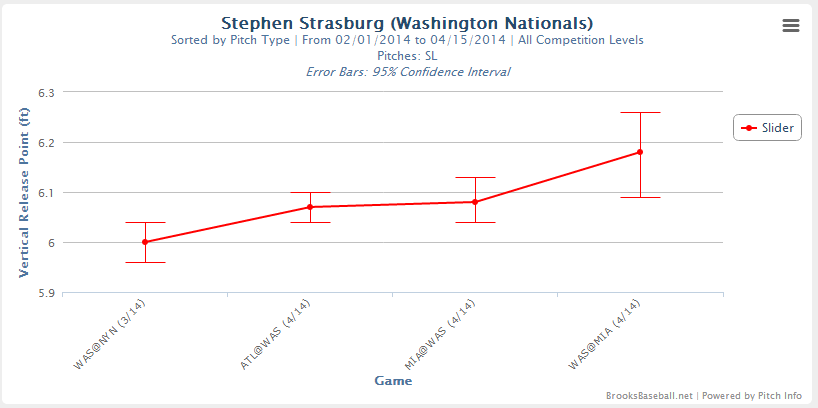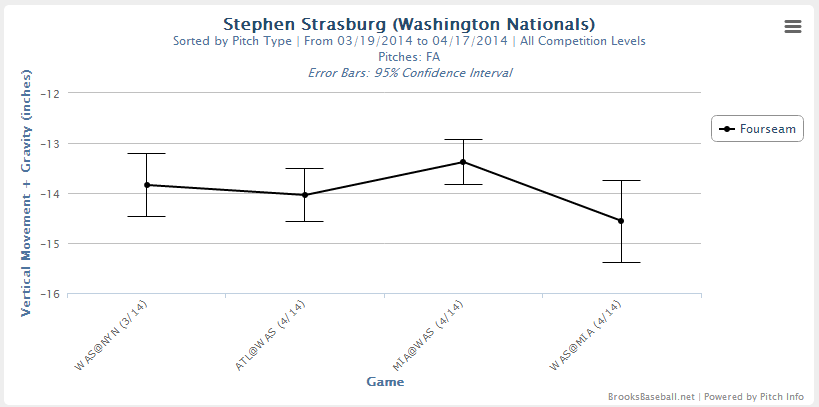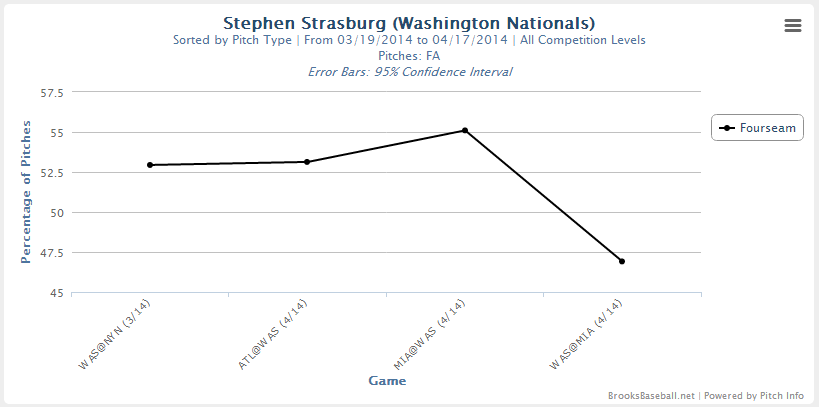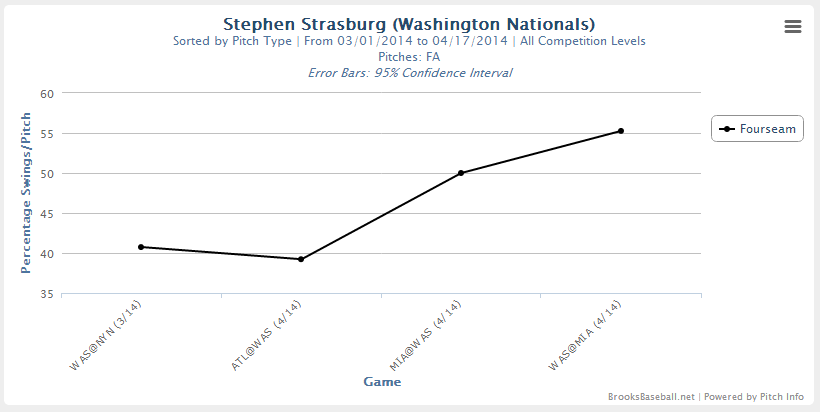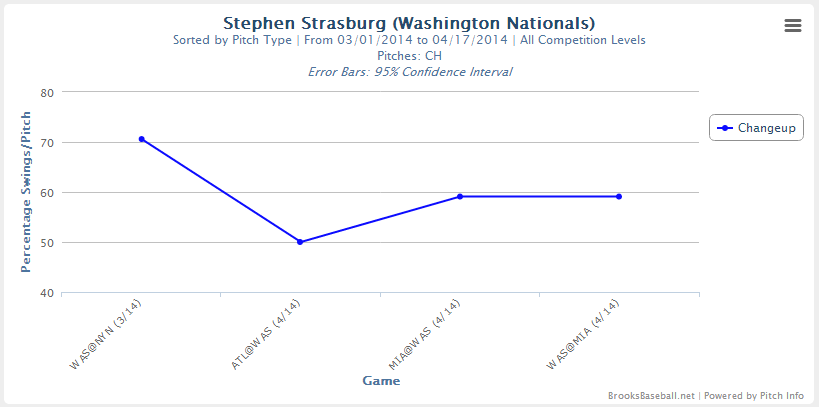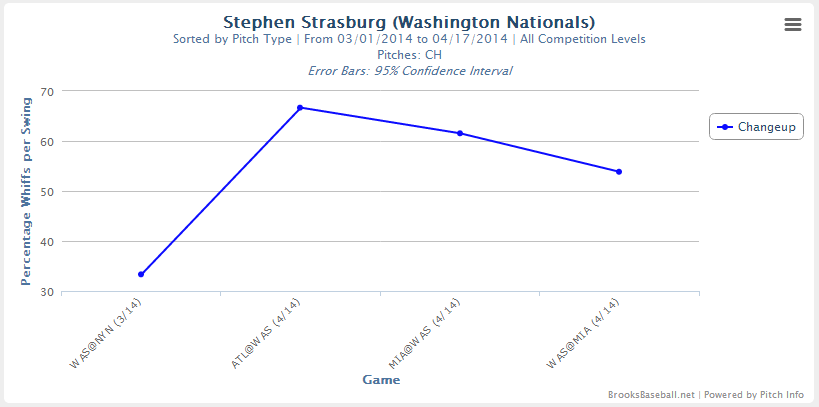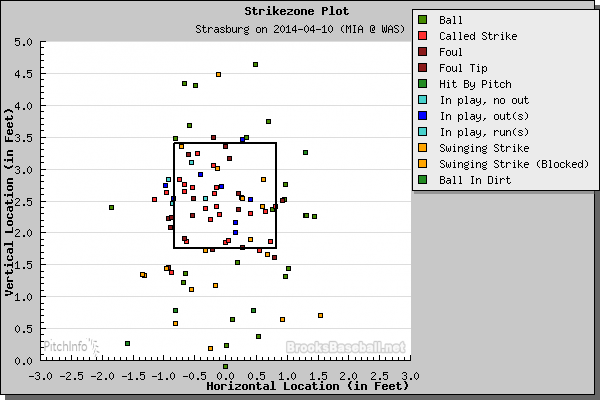Stephen Strasburg‘s last two starts were both against Miami, but they had very different results. In the first game, he went as far as 2 outs in the 7th inning, struck out 12 batters, only walked 1 and gave up 3 hits.
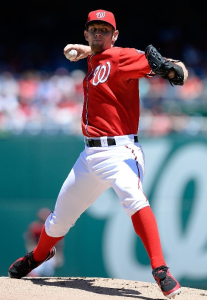 The second start was the opposite – 6 ER, 3 walks and 5 Ks in 4 IP. While some of the results can be blamed on luck, in both instances, he definitely also pitched differently. Actually, the first start against Miami was the only one that’s been really good this year – despite his league leading K/9, he has only pitched great in that one game (since that was the third start of the season, let’s just call this Game 3).
The second start was the opposite – 6 ER, 3 walks and 5 Ks in 4 IP. While some of the results can be blamed on luck, in both instances, he definitely also pitched differently. Actually, the first start against Miami was the only one that’s been really good this year – despite his league leading K/9, he has only pitched great in that one game (since that was the third start of the season, let’s just call this Game 3).
In his second Miami start, the fourth of the season (which we’ll call Game 4), the location of the fastball didn’t seem to be there, and since he couldn’t hit his offspeed spots either, they were just sitting on the fastball. At least, that is what appeared to have happened. So let’s take a look at some of the PitchFX data and see if we can confirm or refute some of that info.
Investigating The Movement
First thing I looked at was the actual movement of his pitches, and there was really nothing out of the ordinary there. From one start to the other there was a little change each time, but there wasn’t anything that screamed “look up here!” at any reason for the difference. So we move on.
His release points were different, though, but they were all bunched together in each game… So does this signify just the minor differences in measuring where his release point is based on the different cameras at different parks? I lean towards yes, it does.
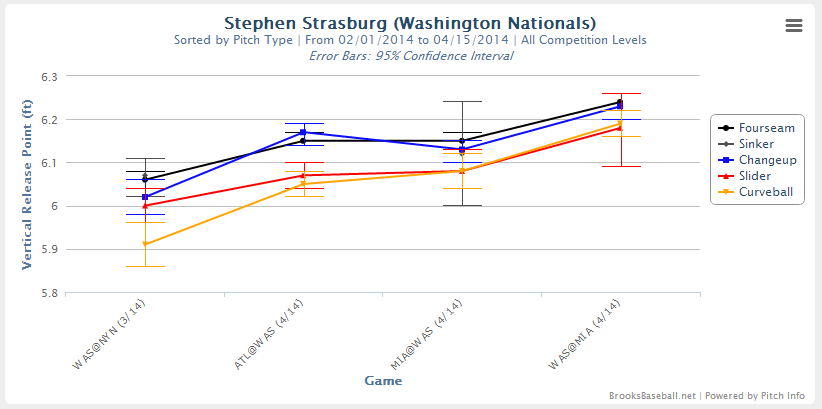 So if that’s that, we can move on. I mean, what I was really looking for was ONE pitch having a strange release point, that fastball, and the rest looking normal. So none of that… but wait, what’s that? There is one quirk here, and if we filter out all the pitches except the slider, suddenly we get this:
So if that’s that, we can move on. I mean, what I was really looking for was ONE pitch having a strange release point, that fastball, and the rest looking normal. So none of that… but wait, what’s that? There is one quirk here, and if we filter out all the pitches except the slider, suddenly we get this:
Ah, well now we have something. It’s not the fastball, but boy o boy that slider release point seems to have been wildly inconsistent in Game 4, just a tick below twice as varied as in Game 3. Unexpected indeed, so let’s dig in on that a bit. What was the slider doing after it left his hands at these weird spots?
Now, before we get too caught up in this, it’s worth noting that he only threw 11 sliders in Game 3 against Miami, and 6 sliders in Game 4. Considering the amount of pitches he threw in each game, that’s at an 11.2% rate vs a 7.4% rate. In other words, he didn’t throw it a ton, so let’s not read too much into it. But note that he didn’t decide to avoid using it in Game 4 even though it wasn’t working right.
That being said, is there anything with the results that are interesting? Well, I won’t show all the charts, but in Game 3, they didn’t get a hit off of his slider whereas in Game 4 they hit 1.000 and slugged 2.500 against it. So… yeah, major difference there. Another difference that stands out in the charts is the release speed. In Game 3 the slider came out of his hands at a mile and a half slower than in Game 4.
Due to whatever – the speed, the release point, the weather, there was a change in the vertical movement and horizontal movement of the pitch. The pitch moved an extra half an inch (2.09 to 2.59) in Game 4, and dropped two-and-a-half inches less (30.63 to 28.09) in Game 4. While the horizontal movement looked as wild and as varied as it did in every other game, the vertical was definitely dropping less with a much higher variance.
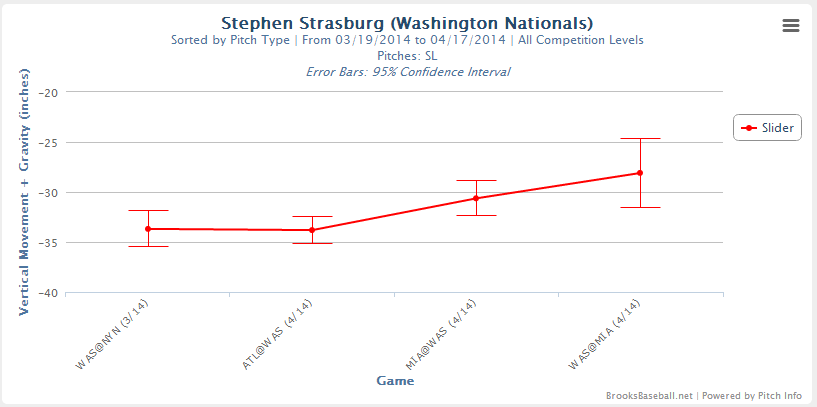 Another indicator right there that slider wasn’t doing what it should… beyond that I’m not sure what we can do from here, other than noting that his release point seemed to be very inconsistent on his slider.
Another indicator right there that slider wasn’t doing what it should… beyond that I’m not sure what we can do from here, other than noting that his release point seemed to be very inconsistent on his slider.
Digging in on the Fastball
So all of that tells us that there were certainly some differences with the slider, but what about that fastball? That’s what we were going after anyway. Is there anything that seems like anomaly with that?
There wasn’t much to note about the release point, but the velocity was actually down 0.71 mph from his previous start. With that reduced velocity, there was a much bigger vertical drop in the fastball:
More varied, more drop – the fastball might have been harder to command because it wasn’t doing what it normally did. Nothing wrong with keeping the ball down in the zone, but perhaps when it’s due to a little (presumed) unintentional reduced velocity, it isn’t such a good thing. That variance also suggests he was having trouble with command – it certainly wasn’t going anywhere consistently on the vertical plane.
And if you weren’t comfortable with the fastball, neither was Strasburg. He used it less than half the time – for the first time all season.
It certainly looks like a big difference. Looking back, it was only the fourth time since the beginning of 2013 he used it less than half the time. And the results from those game?
4/7/13: (45.45% fastball use): 5.1 IP, 6 ER, 9 H, 4 BB, 5 K
4/24/13: (49.52% fastball use): 7.0 IP, 3 ER, 5H, 1 BB, 7 K
8/5/13: (49.11% fastball use): 7.0 IP, 2 ER, 5 H, 1 BB, 9 K
4/15/14: (46.19% fastball use): 4.0 IP, 6 ER, 8 H, 3 BB, 5 K
Before you start saying that those are two good starts and two bad ones… yes, one of those starts was really good, on August 5th, 2013. The one on April 24, 2013 wasn’t exactly bad but Strasburg only had 9 starts last season with 3 or more ER, out of 30 total starts. Just over 2 out of 3 starts had fewer than 3 ER – so you have to consider that a relatively poor start. Those two starts, however, were a rounding error away from 50% usage of the fastball. The other two starts were just plain bad in most every way, and were not nearly as close in the fastball usage.
That tells us that when he is most clearly uncomfortable throwing his fastball, he doesn’t pitch well. It sort of confirms the initial hypothesis that he didn’t have much feel for it, and the results… here are a few charts that help us see what happened. First, starting with whiffs per swing:
They saw the fastball and they swung at it. More than any other game this season. They didn’t miss it much, although it wasn’t as bad as the early games this season. In fact, while the numbers against the fastball looked bad compared to Game 3, they were pretty bad in Games 1 and 2 as well. The difference, though was that they also hit the curve and the slider well. Perhaps it goes back to the frequency of use, but hitting those two offspeed pitches well, in addition to the fastball, made it so there was very little that Stras could throw that wouldn’t be hit.
The one thing he could throw, though, was the the changeup. He threw that 22 times in Game 3 and 22 again in Game 4 and they saw no success against it. They swung at it more than half the time it was thrown, whiffed on those swings more than half the time, and got base hits none of the time. So if there’s one positive thing to take away is that despite some issues with feel this season on most of his pitches, his changeup remains elite. Check out the swing rate:
And the whiff per swing rate:
Just like the fastball, when they saw the changeup, they swung at it. Unlike the fastball, though, they usually missed it. Maybe because, I dunno, the changeup looks an awful lot like the fastball to the hitter.
Plotting Strikes and the Future
In the end, one of the big differences between Game 3 and Game 4 can be seen in where the ball ended up – and I don’t mean in the outfield or in the stands. Here is the location chart for Game 3:
And here it is for Game 4:
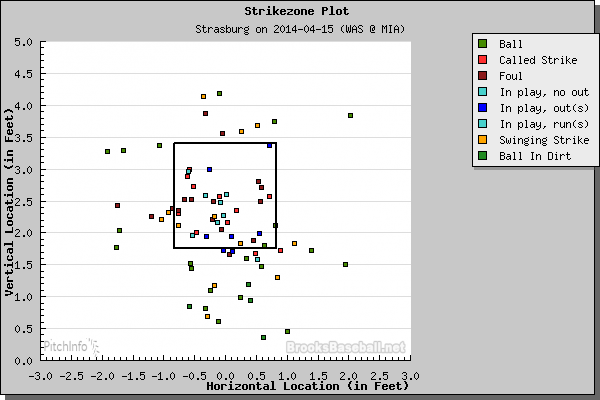 The first thing I notice is how many more pitches ended up way inside or outside in Game 4 as opposed to Game 3. The lack of control manifested not in high and low pitches, but with inside and outside pitches. In his spectacular Game 3 start, he was able to to succeed despite having plenty of pitched above and below the strike zone.
The first thing I notice is how many more pitches ended up way inside or outside in Game 4 as opposed to Game 3. The lack of control manifested not in high and low pitches, but with inside and outside pitches. In his spectacular Game 3 start, he was able to to succeed despite having plenty of pitched above and below the strike zone.
But another thing I noticed after staring for a while was that in Game 3, he had a bunch of balls just to the left of the zone, and just to the right. There was still plenty down the middle, but his misses were so close that they were often fouled off or put into play, resulting in an out. Painting the black, as it were, shows up here.
He was much better in Game 3 than in Game 4 because he was hitting his spots more in Game 3, he used the fastball more, it did what he wanted it to, and they were hitting his slider and curve less. In order to see success, that fastball is probably the key element, but it’s interesting to note that no matter how he’s pitched, the changeup remains untouchable.

